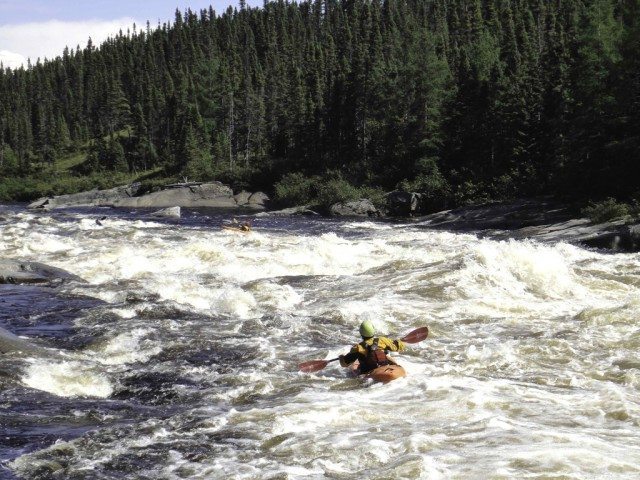Features
The Descent has features that have become almost standard on kayak-specific rescue PFDs, including a quick release rescue harness, full-strength shoulder straps integrated into the rescue harness, a quick release loop to keep a tow-tether, pockets for carabineers, prusiks, snacks, etc., and a lash tab for a knife.
Unlike the Astral Green Jacket, the Descent does not come with a full-strength spectra “belay” loop on its front. While some paddlers say you should never wear a vest without this feature, in my opinion, the spectra loop’s utility is limited and you can accomplish the same purpose with a length of tubular webbing.
- Shoulder Straps
These are possibly the best features of the Descent. The shoulder straps have plastic inserts set under tough, sticky “nail-cloth” tops that make shouldering a boat feel almost easy. I have done multiple major hikes (6+ miles and ~1000’ of elevation change) with my boat on my shoulder in this vest, and these hikes were made much more comfortable by the shoulder strap construction.
To put this in perspective, every time I’ve paddled in a different vest (like the Astral Green Jacket, NRS Zen, or Kokatat Ronin Pro) my delight at wearing a better fitting vest faded to a distant memory as soon as I put my boat on my shoulder and carried it more than 30 feet. I might just have wimpy shoulders, but the stiffened shoulder strap is a clear winner in my book.
- Quick Release
The quick release on the rescue harness is easy to access when you need to release it (something I’ve tested on several occasions) and it releases smoothly under tension.
The integrated shoulder straps also provide good support while performing tethered rescues. The small quick release loop for a tow-tether is well located, releases when needed , and stays put when it’s not in use.
- Pockets
There are two pockets on the Descent, one primary zippered pocket with neoprene sides to expand and one mesh pocket with an elastic top directly on top of the zippered pocket. The zippered pocket stays closed and does a good job keeping its contents inside in turbulent conditions (as issue with the past generation of the Green Jacket), but it’s difficult for someone with large hands (me) to get things in and out.
When it’s quite full, it adds a couple inches to the front of your vest, making it difficult to get your torso over your deck when stomping boofs or tucking off big drops or into holes. The elastic pocket on the outside of the vest is only useful to store things if you’re not going to be flipping over or getting hit by waves. This means it’s basically only good for flatwater paddling or holding a beer, which is does exceptionally well.
- Lash Tab
The lash tab for the knife is located at bottom of the vest in the center of the front pocket, and really the only way to attach a knife is with its handle pointing either right or left. Since the tab is on the pocket means that your knife has a lot of play in it, and longer knives like the NRS Pilot tend to get hung up on things and can tear your skirt if you playboat with it.

Durability
With its tough exterior fabric and high-quality seams, I’ve found the Descent to be exceptionally durable so far. After 300 days on the water (more than you’d expect from most other vests), the only significant sign of wear is the slightly sun-faded fabric.
Bottom Line
Stohlquist hit the mark with the Descent when it comes to key safety features, durability, and functional shoulder straps. But when it comes to fit and on-water comfort, I think this PFD leaves something to be desired.
At $189, the Descent does cost less than some other high-end rescue vests, but it does come with some potential comfort drawbacks. Since you can’t adjust the shoulder straps, trying this vest on before buying it is imperative. But if you’re shorter than I am, you might not experience these same fit issues.
I want to end with a comment about the Descent’s shoulder straps. This is the feature that I think all manufacturers (and customers) need to take note of since it makes portaging much less painful.
